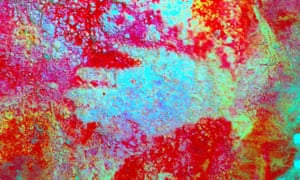Jonathan Jones - So Neanderthals made abstract art? This astounding discovery humbles every human
The Neanderthal hand is the first evidence ever
found of another species showing cultural self-consciousness. It’s not so very
far from a hand print to a self-portrait to a diary to a novel. This discovery
dethrones the modern human mind.
If you go to the painted caves of Spain and France, crawl through narrow passages and keep your balance on slippery rock floors, you reach the hidden places where ice age hunters made their marks tens of thousands of years ago. Nothing seems more startling than the way they placed hands against the cold rock and blew red ochre out of their mouths to leave fiery images. Of what though?

Leaving a mark … a colour-enhanced hand stencil from La Pasiega in northern
Spain, now dated back 66,700 years. Photograph: Reuters
Up to now we called it
the human presence. “The print of the hand says, ‘This is my mark. This is
man’,” declared the scientist Jacob Bronowski when he visited caves in northern
Spain in his classic TV series The
Ascent of Man. Simon Schama visits those same caves in the BBC’s new epic
series Civilisations and
raves about those same handprints. For what could communicate the curiosity,
self-assertion, intelligence, and above all self-consciousness of our unique
species Homo sapiens, more clearly that this desire to literally
leave our mark?
Except it is not
unique to Homo sapiens at all. The potentially epoch-making
announcement in the journal Science this week of a new dating for art
in some of Spain’s painted caves includes the astounding discovery that a
stencilled hand in Maltravieso cave is at least 66,700 years old – a date
reached by testing the calcite deposits that have encrusted it over the
millennia.
That is long before
modern humans are known to have reached Europe on their migration out of
Africa. It is also more than 25,000 years before the first paintings made
by Homo sapiens in Europe were created at Chauvet in France.
The Maltravieso hand
is not human, at least not Homo sapiens. It has to be that of a
Neanderthal, the early species that hunted the big beasts of ice age Europe
before our lot came along, only to mysteriously
vanish about 40,000 years ago, soon after our arrival…
read more:
